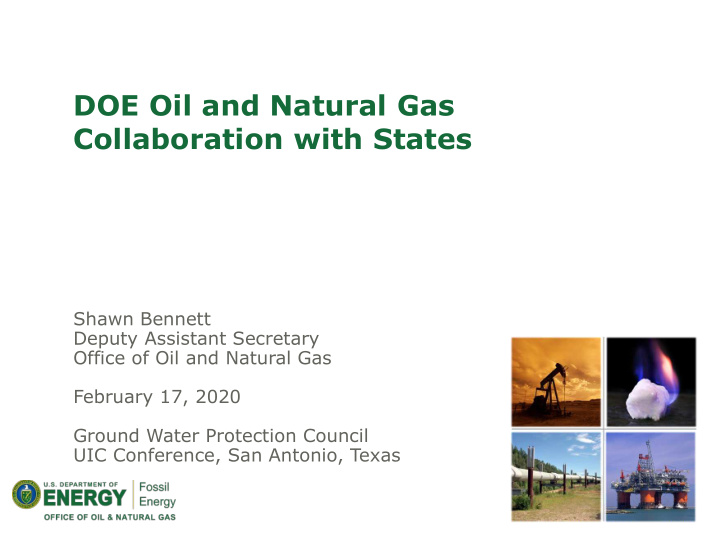



DOE Oil and Natural Gas Collaboration with States Shawn Bennett Deputy Assistant Secretary Office of Oil and Natural Gas February 17, 2020 Ground Water Protection Council UIC Conference, San Antonio, Texas
Oil and Natural Gas Continue to Fuel the Economy Energy production (AEO2020 Reference case) quadrillion British thermal units Key E Elemen ments: 2019 50 history projections dry natural gas Resou sources s • 45 40 • Technol olog ogy 35 • Infr nfrastructure 30 crude oil and lease • Supportive ve 25 condensate regulatory/po y/policy 20 framework fr other renewable 15 coal Federal-Sta Fe tate • 10 natural gas plant collaborati tion liquids 5 nuclear hydro 0 1990 2000 2010 2020 2030 2040 2050 Source: EIA, Annual Energy Outlook 2020 2
Expanded Energy Supplies for Economic Growth and Energy Security Source: EIA, Annual Energy Outlook 2020
DOE’s Oil and Natural Gas Program Mission: Maximize the value of U.S. oil and gas resources to the public and ensure their responsible development and delivery through policy, research, innovation, and outreach Upstream Oil & Natural Gas Gas Hydrates R&D Natural Gas R&D Infrastructure R&D Natural Gas Policy Analyses & Import/Export - LNG International Relations 4
Smarter, More Efficient Resource Recovery Field Laboratory Locations Improving Enhanced Oil Recovery Performance Through Field Pilot Test of Foam-assisted Hydrocarbon Data Analytics and Next-Generation Controllable Gas Injection in Bakken Formations Completions First Ever Field Pilot on Alaska’s Chemically Enabled CO 2 -Enhanced Oil Recovery North Slope to Validate the Use in Multi-Porosity, Hydrothermally Altered of Polymer Floods for Heavy Oil Carbonates in the Southern Michigan Basin EOR CO 2 Enhanced Oil Recovery Bakken Rich Gas Enhanced Oil Recovery Improvement in Conventional Fields Using Rich Gas Unlocking the Tight Oil Reservoirs of the Powder River Basin, Wyoming Conasauga Shale Research Consortium Marcellus Shale Energy and Improving Production in the Emerging Environment Laboratory Paradox Oil Play Field Laboratory for Emerging Stacked Unconventional Plays in Central Appalachia Hydraulic Fracture Test Site II Field Evaluation of the Caney Shale as an Emerging Unconventional Play, Southern Oklahoma Engineered Water for First Generation The Eagle Ford Shale Laboratory Hydraulic Fracture Test Site Improvement of Oil Recovery New Phase from Fractured Reservoirs Tuscaloosa Marine Shale Laboratory New Awards 5
WATER CROSSCUTS DOE AND OUR COLLABORATION WITH STATES DOE Water Security Grand Challenge. DOE, USGS and EPA are partnering to transform produced water from a waste to a resource. Initial workshop Oct. 2018. States Leveraging Efforts to Enable Informed Regulatory Decision Making and Increased Transparency . Risk Based Data Management System (RBDMS). Over 20 states and the Osage Nation use RBDMS -- an integrated suite of data management tools -- for managing oil and gas regulatory data. Launched in 1992 with DOE support. With NorthSTAR, North Dakota is undertaking a major system upgrade, adapting new innovations previously developed for California WellSTAR. Texas LoneSTAR is under development. FracFocus.org. Jointly sponsored by the Ground Water Protection Council and Interstate Oil and Gas Compact Commission. 26 states require or allow operators to use this national registry for the public disclosure of chemicals used in hydraulic fracturing. Ground Water Protection Council releases its Produced Water Report which examines current regulations, practices, and research needed to expand the use of produced water, a byproduct of oil and gas production, as a resource. June 2019. 6
Address the Energy Water Nexus Advance transformational technology and innovation to meet the global need for safe, secure, and affordable water. By 2030: Launch desalination technologies that deliver cost-competitive clean water. 1 Transform produced water from a waste to a resource . 2 Achieve near-zero water impact for new thermoelectric power plants, and 3 significantly lower freshwater use intensity within the existing fleet. 4 Double resource recovery from municipal wastewater. Develop small, modular energy-water systems for urban, rural, tribal, national 5 security, and disaster response settings. White House Roundtable and Stakeholder Engagement. Secretary Perry convened leading experts on water quality in 2018 to discuss competitive prizes to catalyze innovation in critical water issues and a request for information to solicit public comments on key water issues that could be tackled through prizes and challenges.
RBDMS: Data and Analytic Tools for State Regulators and Resource Managers Developed by the GWPC and States in partnership with DOE, RBDMS is a suite of integrated modularized software products that assist states agencies in the effective regulation and oversight of oil, natural gas, injection and other facilities, and resource management. PRODUCTS Field Core Inspection RBDMS eForms Environmental Data WellFinder Explorer GIS AOR Interface Gas RBDMS Storage Wellbore Seismic Monitoring 8
Policy Analyses & International Relations National Petroleum Council • Federally chartered advisory committee that advises the Secretary of Energy on matters related to oil and natural gas and the oil and natural gas industries • Established in 1946 at request of President Truman • Since its establishment, the NPC has prepared over 200 reports for the Department 2019 2014 9
www.energy.gov/fe/science-innovation/oil-gas-research www.netl.doe.gov/research/oil-and-gas February 21, 2016 Solutions for Today | Options for Tomorrow
Recommend
More recommend